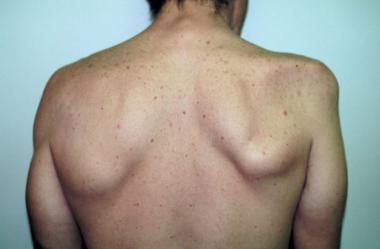Parsonage-Turner Syndrome (PTS), also referred to as idiopathic brachial plexopathy or brachial neuritis, is a rare neurological disorder which consists of complex constellation of symptoms with sudden onset of shoulder and arm pain, usually involving only one side, followed by progressive neurologic deficits of motor weakness, dysesthesias and numbness. The exact cause of the disease is still unknown. However, it is reported in various clinical settings including some sort of antecedent impact on the patient, it can be surgical, infectious, traumatic or even therapeutic, such as cases involving vaccinations or antibiotic treatments.
A normal healthy individual can get affected with this disorder with sudden, rather abrupt, unilateral shoulder pain that may begin gradually, but quickly amplifies its strength and severity. The pain is often described as sharp, aching, burning, stabbing or throbbing. In some cases, the pain may extend to the neck, lower arm and/or hand on the affected side. People affected with the syndrome can experience constant pain that gets worse with movement. Acute pain can last from a few hours to several weeks, at which point the intensity starts to subside. However, mild pain may linger for a prolonged time. As the pain ameliorates, it generally is replaced with progressive weakness of the affected area, ranging from mild weakness to complete paralysis. Weakness may be accompanied by muscle wasting (atrophy), absent or reduced reflexes or sensory abnormalities that typically involve the shoulder girdle musculature and proximal upper limb muscles.
In rare cases, nerves and muscles outside of the shoulder and upper arm region are affected such as causing leg symptoms or affecting the diaphragm.
Early diagnosis of the condition can help avoid unnecessary and potentially harmful diagnostic and therapeutic interventions and avoid delays in prescribing appropriate therapies that may be helpful only early in the course of the disease. In majority of cases no triggering or underlying cause can be identified. Factors that are suspected to trigger the condition include:
- Infections (both viral and bacterial)
- Surgery
- Vaccinations
- Childbirth
- Certain medical procedures, such as a spinal tap or imaging studies that require administration of radiologic dye
- Strenuous exercise
- Certain medical conditions, including connective tissue disorders and autoimmune disorders
- Injury
There are two main types of Parsonage-Turner syndrome, idiopathic and inherited. The most common type is idiopathic, which may arise as a result of your autoimmune response, which means body system attacking your nerves. It can happen following exposure to an illness or environmental factor. Researchers believe Parsonage-Turner syndrome can be a multifactorial condition (a combination of environmental and genetic factors). A person may have a genetic predisposition to Parsonage-Turner syndrome, but won’t develop the condition till they are exposed to such environmental triggers.
Symptoms:
The primary symptom of this disease is pain which may give way to muscle weakness over the course of the time. The severity and length of these phases vary from person to person. The symptoms may include:
- sudden, intense shoulder pain that is often described as stabbing or burning, usually in the right shoulder, but in some rare cases, in both shoulders
- pain that becomes worse if you move your shoulder
- pain that is only relieved by the strongest painkillers and remains constant for a number of hours or even weeks
- weakness or paralysis in the shoulder muscles as the pain goes away
- muscle atrophy, which is decrease in muscle mass
- areas of numbness that occasionally develop in your arm or shoulder
- shortness of breath, which occurs if the nerve to your diaphragm is affected
Treatment:
Usually Parsonage-Turner syndrome is treated with medications and physical therapy. However, rarely, your doctor may suggest a surgery.
Medication and exercise: Initial treatment starts with painkillers. Once the pain is under control, the focus shifts to helping you regain normal functions of arm and shoulder. To strengthen your muscles, you may need to follow a set of active and passive exercises. The service of a physical therapist can be sought.
Surgery: Surgery is reflected upon only if your symptoms do not show any signs of improvement even after a period of about two years. Surgery is aimed to restore muscle function. Tendon transfers can also be considered.
Long-term outlook:
After a period of time, pain associated with Parsonage-Turner syndrome will settle. However, it may take a few months for the muscle weakness to resolve. The general rule is that, the longer the pain lasts, the longer your overall recovery will take. In some people, muscle weakness can last for years and a few are left with permanent loss of strength, albeit mild.
Parsonage-Turner syndrome: An uncommon cause of shoulder pain
Patients with Parsonage-Turner syndrome are often misdiagnosed as having cervical radiculopathy. In case of this disorder, patients may exhibit severe shoulder and upper arm pain followed by marked upper arm weakness. With the help of magnetic resonance imaging, it can be found out if there is any degeneration in the shoulder and upper arm musculature, allowing prompt diagnosis. Electromyography, done three to four weeks after the symptom onset, can identify the disease and help affirm the diagnosis. First-line treatment includes analgesics and physical therapy, with symptoms subsiding usually in three to four months. It is important to avoid misdiagnosis in a patient with Parsonage-Turner syndrome.
For enquiries related to Parsonage Turner Syndrome or any other shoulder problems, send a message to www.BangaloreShoulderInstitute.com/contact

